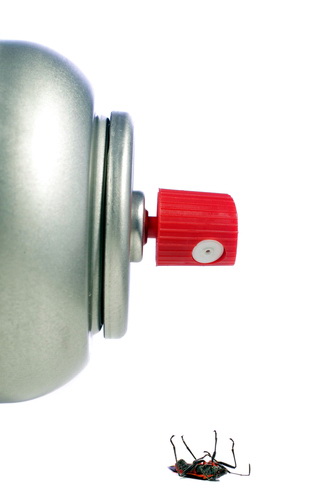How Do Insects Become Resistant to Insecticides?
By Chris Williams on April 3, 2013.
 Insects often develop resistance to the insecticides that we use against them. When that happens, the insecticide becomes less effective until sometimes we can no longer control the population with this insecticide. Sometimes we can switch to a different insecticide and get results. But sometimes that resistance is broad spectrum, severely limiting the number of products that will work.
Insects often develop resistance to the insecticides that we use against them. When that happens, the insecticide becomes less effective until sometimes we can no longer control the population with this insecticide. Sometimes we can switch to a different insecticide and get results. But sometimes that resistance is broad spectrum, severely limiting the number of products that will work.
You see a similar process with the use of antibiotics against diseases in human populations. The more a certain antibiotic is used against a disease, the more likely it is that, over time, the disease will become resistant to that antibiotic, and sometimes to related antibiotics. That antibiotic no longer works against that disease and medical experts search for a newer, effective antibiotic.
Resistance in insects develops when the same insecticide (or class of insecticides) is used against a pest population over and over again. Some insects will survive the same dose that kills their friends. Those that survive pass on that survival trait to their offspring. The survival trait can be a learned avoidance of the insecticide, or development of a thicker shell, or a change in the way the insect metabolizes the insecticide.
The speed with which resistance develops in a population of insects depends on how quickly the insects produce each generation and how often they are exposed to the insecticide. If the same insecticide is applied continually, a higher and higher percentage of the population will become resistant to the insecticide as most of the susceptible insects are killed and only the resistant ones are left to breed. More insecticide has to be used since the same amount of insecticide that used to kill, say, 99% of the insects treated, now kills only 50%, or 20%, or none at all.
Pest control professionals often face “cross-resistance,” as well. This happens when not only is the insect resistant to a certain insecticide but is also resistant to other insecticides that belong to that same class of products—often even though it has never been exposed to those other products.
Cockroaches are notorious for developing insecticide resistance. It seems like we no sooner throw a new insecticide at them, than they’re resistant to its effects. One of the bigger problems pest control companies are facing right now is insecticide resistance that has developed in bed bugs. Bed bugs in the U.S. are almost universally resistance to all pyrethroid insecticides. In fact, bed bugs were resistant as soon as they first reappeared in the U.S., about 15 years ago. Pyrethroids are the most common class of insecticides in use today, comprised of many different products. Insecticide manufacturers are scrambling to come up with new products that will work against bed bugs.
One way to avoid the development of resistance probably seems pretty obvious: use different insecticide products, don’t rely on just one insecticide. Pest control technicians practice product rotation where they switch insecticides every few months. It’s important to switch to a completely different class of insecticides to avoid cross-resistance in the insect population. It can also help to switch to a product that has a completely different mode of action, for example, instead of a spray, use an insecticide bait. Professionals also rely more on non-insecticide control methods. For bed bugs, that can include heat or steam treatments, trapping, and improved sanitation.